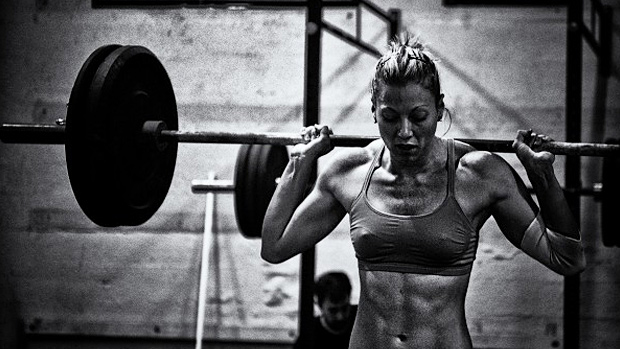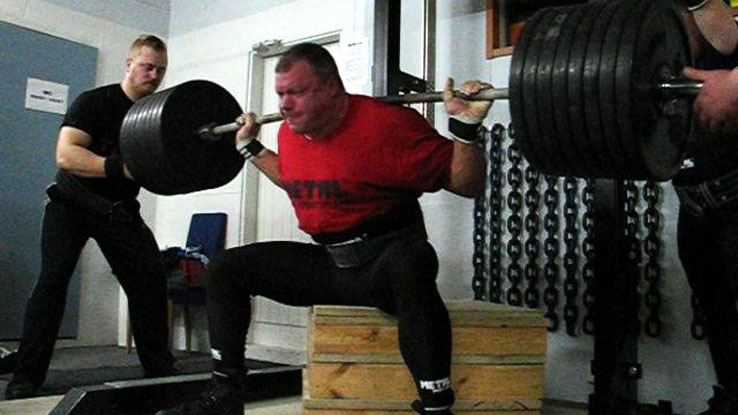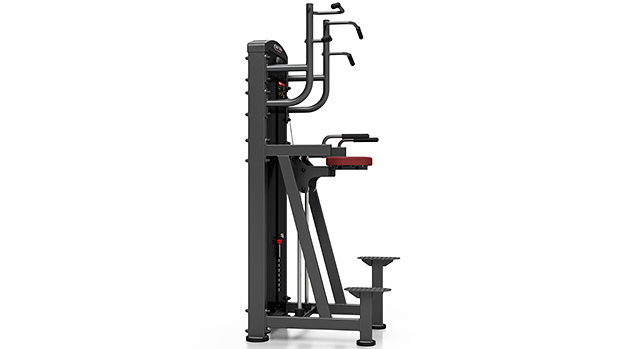A Better Way
I'm a huge believer in using the "alternating set" system when training. For time management reasons, I tend to do exercise one for a set, rest 60 seconds or so, exercise two for a set, rest 60 seconds or so, and continue. This allows me to increase work density while still getting "true" rest.
In other words, I perform a set of squats, rest 60 seconds, perform a set of push-ups, rest 60 seconds, and repeat. So, in effect, I've almost tripled the rest period between squat sets (60 seconds plus time taken for push-ups plus 60 seconds) as opposed to using a straight set system. And for fat loss training, it's unparalleled.
However, the biggest problem or complaint I get from clients who use commercial facilities is that it's really hard for them to tie up two pieces of gym equipment at peak hours. I have my own facility, but I realize this can be a real problem elsewhere.
So I started experimenting with a few things – doing dumbbell lunges and push-ups for example, or step-ups and dumbbell bench presses – where I could use one set of dumbbells and one piece of equipment.
It was an okay compromise, but it started to somewhat limit my exercise selection. And to be honest, it still had the issue of people working in and possibly disrupting your rest periods.
So I went a step further. What if I created a fat loss or conditioning program based around one piece of equipment – where you stayed in the same spot, using the same load for the entire duration.
So I tried it. At first it was awkward, but after reading Steve Javorek's stuff and talking with über-strength-coach Robert Dos Remedios, I started to implement different variations of combination lifting. I just hoped that it would work as well as alternating sets for fat loss and conditioning, or at least close enough that it wasn't too much of a tradeoff.
As it turns out, it worked better! In fact, it worked so well that it became a cornerstone of my conditioning programs with several athletes.
The Definitions
Now I'm not the first person to ever use complexes. But after talking to Dos we couldn't find any formal classification of what constituted the difference between combination lifts, hybrid lifts, and complexes. So we felt the need to define the term:
Combo lifts are broken down into three categories:
1. True Combinations
This is when two or more lifts are done together with a distinct pause between each. (Still, never put the bar down.) Example: Power clean + front squat.
2. Hybrids
In this category, there's no pause or separation between the lifts. The movements flow into one another. In fact, the previous movement sometimes isn't completed before the next starts. Example: Front squat into press.
3. Complexes
Still doing two or more exercises and still not putting the bar down, only now you complete all your reps with one movement first, then complete all your reps with the next movement. Example: When combining a squat with an overhead press, perform 5 reps of squats first, then 5 reps of overhead press without dropping the bar.
So why do they work? Well, quite honestly, it's because they're hard as hell! A five-movement complex x 6 reps has a total volume of 30 reps per set! But rather than do a 30-rep set of one exercise (and have to use the pink dumbbells), you're only doing 6 reps before changing the exercise, so you can stay (relatively) heavy.
At only 100 pounds, that comes out to 3000 pounds of total work per set. Do four sets with about 90 seconds rest between sets and you'll have moved 12,000 pounds in about eight or nine minutes.
Using Complexes
- Combo lifts are great for those who lack equipment or space. They can make good warm-ups, or can be used for metabolic work or for in-season athletic training because they're time efficient.
- If you want to try combos, use familiar movements. Don't put unfamiliar exercises together.
- The weakest exercise in the sequence determines the load you'll use. Don't use exercises like triceps kickbacks because the small load required is too limiting for the other movements in the combo.
- Use exercises that flow well together. Performing a deadlift to a Romanian deadlift to a high pull flows very well as the end point of one exercise overlaps with the start point of another exercise. Doing back squat to floor press clearly doesn't flow.
- Easy rule: If you have to re-grip the bar or adjust your grip at all, it has to be seamless and easy; otherwise the complex breaks down. The key is to be sensible. You can't do a hybrid of deadlifts and curls for example – the difference in loading is too great.
To summarize, here are the four main reasons to consider combos or hybrids:
1 - Time / Space / Equipment
- Small facility + large group
- Lack of equipment – Got dumbbells and/or barbells?
- Only have your clients or athletes for limited time periods or sessions per week
2 – Increase Training Volume
- Add volume to your Olympic variations
- A five-movement complex x 6 reps has a total volume of 30 repetitions per set. At only 100 pounds, this comes out to 3000 pounds of total work per set!
3 – Change-up: Break-up Monotony (this is more for athletes)
- Long in-season cycles
- Off-season loss of focus
- Unloading phase
- Break-up a long microcycle phase (i.e. hypertrophy, high volume)
4 – Metabolic / Conditioning Effect
- Increase work demand, use more muscle groups
- Increase caloric expenditure in fat loss programs
- Increase EPOC/Afterburn effect massively
- Increase work capacity
- Complexes for Fat Loss

Be warned, these are pretty grueling. Perform the complexes at the beginning of your workout when you're fresh. They'll elevate metabolism beyond anything you've ever experienced before.
The most frequently asked question about complexes is how much load to use. Remember, it's a metabolic stimulus, not a strength or hypertrophy stimulus, so be conservative. MMA pro David Loiseau uses only 85-95 pounds when doing the complexes I prescribe for him.
Now don't go too light either. A good "Cosgrove rule of thumb" is that if you're not questioning why in the hell you're doing these exercises, or convincing yourself that twice around is enough, you're not going heavy enough.
The Workout
Let's get into it. Perform each complex once per week for four training sessions per week. Use the following progression:
- Week One: 4 sets of 5 reps of each – 90s rest
- Week Two: 5 sets of 5 reps of each – 75s rest
- Week Three: 5 sets of 6 reps of each – 60s rest
- Week Four: 6 sets of 6 reps of each – 45s rest. Then puke.
Complex A
- Bent Over Barbell Row
- Hang Clean
- Front Squat + Push Press Hybrid
- Jump Squat (bar on back)
- Good Morning
Complex B
- Romanian Deadlift
- Hang Clean + Front Squat + Push Press (combo lift – perform one rep of each in series)
- Reverse Lunge (alternate legs)
Complex C
- Deadlift
- High Pull (onto toes)
- Squat Clean (clean the bar from the hang and then drop into a full squat on the catch)
- Military Press (strict)
- Jump Lunges (switch legs) – Insert my evil laugh here!
Complex D
- Jump Squat
- Squat
- Squat and hold for 10s
- Military Press
- Push Press
- Squat and Press (combo lift – perform one rep of each in series)
Note: Try to work all exercises at a speed of 1-2 reps per second.
A Final Warning
This isn't for the faint-hearted or deconditioned. It's not a beginners routine. If you're coming back from injury or illness, don't try this program yet. It's brutal.
But if you follow this routine for four weeks you'll see a very significant improvement in your conditioning and a massive drop in your body fat!





